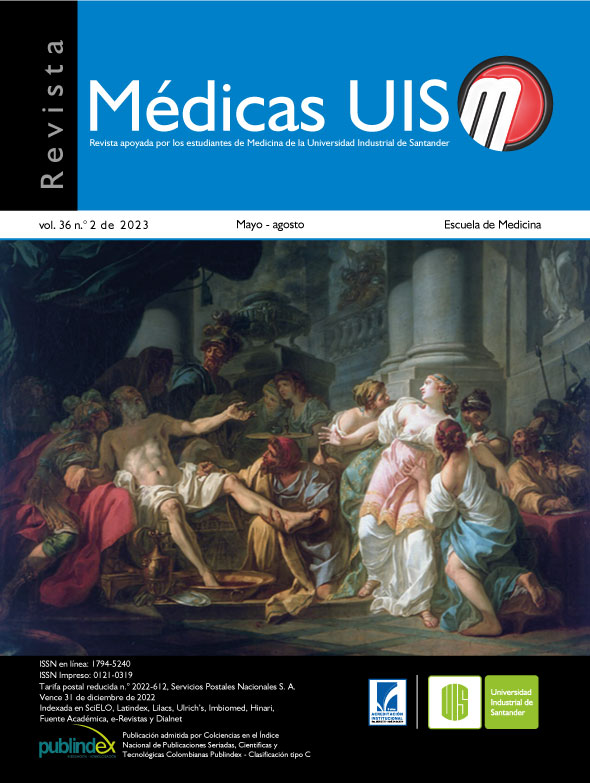Abstract
Background: traumatic brain injury is one of the main causes of infant morbidity and mortality. The sequelae after trauma seriously impact the quality of life of patients and the scientific evidence of associated factors is scarce. Objective: to analyze the factors associated with the development of sequelae due to head trauma in children under 15 years old who went to the emergency room of a hospital in Medellín between 2010 and 2014. Materials and methods: retrospective cohort study. 812 patients were included in a period of 5 years, of which 294 did not meet the inclusion criteria. Sociodemographic and clinical variables were evaluated and the incidence of sequelae was estimated with 95 % confidence intervals using the Wilson statistical method. The relative risk was calculated using log-binomial regression. Results: a total of 518 patients were analyzed. The median age was 5 years, 64,23 % were male children, 75,4 % had mild trauma, and 5 % suffered severe trauma. Falls were the main cause (64,2 %), followed by traffic accidents (25,3 %). The incidence of sequelae was 7,3 % (CI: 5,4 % – 9,9 %). Conclusions: the burden of disease in the patient after TCE represents a public health problem. The probability of developing a sequel in this study was 7,3 %, which is related to the following factors that identify in the emergency department: diffuse injury, a moderate or severe Glasgow scale on admission, and suffering a traffic accident.
References
Dewan MC, Mummareddy N, Wellons JC, Bonfield CM. Epidemiology of Global Pediatric Traumatic Brain Injury: Qualitative Review. World Neurosurg. 2016;91:497-509.
Faul M, Xu L, Wald M, Coronado V. Traumatic brain injury in the United States: emergency department visits, hospitalizations and deaths 2002-2006. Atlanta:Kapil V, McGuireL;2010.
Shi J, Xiang H, Wheeler K, Smith G, Stallones L, Groner J, et al. Costs, mortality likelihood, and outcomes of hospitalized US children with traumatic brain injuries. Brain Inj. 2009;23(7):602–11.
Wegner A, Céspedes P. Traumatismo encefalocraneano en pediatría. Rev Chil Pediatr. 2011;82(3):175–90.
Marchio PS, Previgliano IJ, Goldini CE, Murillo Cabezas F. Traumatismo craneoencefálico en la ciudad de Buenos Aires: estudio epidemiológico prospectivo de base poblacional. Neurocirugía. 2006;17(1):14–22.
Rosselli D, Carlier JC, Arango-Lozano M, Murcia LH, Amaya AF, del Río-McMahon R. Death from external causes in infants in Colombia 2005-2013. Rev Chil Pediatr. 2017;88(4):465-469.
Observatorio Nacional de Seguridad vial. Boletín Estadístico Colombia: Fallecidos y Lesionados por Siniestros Viales. Agencia Nacional de Seguridad Vial. Bogotá, Colombia:Agencia Nacional de Seguridad Vial;2022.
Secretaría de salud de Medellín. Indicadores básicos: Situación de salud de Medellín, Colombia. Medellín:Alcaldía de Medellín;2015.
Vázquez-Solís MG, Villa-Manzano AI, Sánchez Mosco DI, Vargas-Lares JJ, Plascencia-Fernández I. Pronóstico del traumatismo craneoencefálico pediátrico Estudio de una cohorte dinámica. Rev Med Inst Mex Seguro Soc. 2013;51(4):372–377.
Barlow KM, Crawford S, Brooks BL, Turley B, Mikrogianakis A. The Incidence of Postconcussion Syndrome Remains Stable Following Mild Traumatic Brain Injury in Children. Pediatr Neurol. 2015;53(6):491–497.
Lacerda J, Abreu D. Traumatismo craneoencefálico en pediatría. Nuestros resultados. Rev Neurol. 2003;36(2):108–12.
Alway Y, Gould KR, Mckay A, Johnston L, Ponsford J. The evolution of post-traumatic stress disorder following moderate-to-severe traumatic brain injury. J Neurotrauma. 2016;33(9):825–31.
Parrado L, Gómez C, Valderrama JA, Beltrán M, Sierra A, Enríquez J, et al. Traumatismo craneoencefálico pediátrico secundario a heridas por arma de fuego en un Hospital General en Cali, Colombia. Cir Pediatr. 2017;30(1):50–6.
Işik HS, Gökyar A, Yildiz Ö, Bostanci U, Özdemir C. Pediatric head injuries, retrospective analysis of 851 patients: An epidemiological study. Ulus Travma Acil Cerrahi Derg. 2011;17(2):166–72.
Soto DA, Vélez AQ, Gallo AM, Ochoa WC. Epidemiología del trauma encefalocraneano (TEC) en 90 lactantes mayores y preescolares atendidos en un servicio de urgencias pediátricas de tercer nivel, en Medellín, Colombia. Iatreia. 2008;21(3):271–9.
Sullivan KM, Dean A, Soe MM. OpenEpi: a webbased epidemiologic and statistical calculator for public health. Public Health Rep. 2009;124(3):471- 474.
Hannan EL, Farrell LS, Meaker PS, Cooper A. Predicting inpatient mortality for pediatric trauma patients with blunt injuries: a better alternative. J Pediatr Surg. 2000;35(2):155-159.
Pavlovic D, Pekic S, Stojanovic M, Popovic V. Traumatic brain injury: neuropathological, neurocognitive and neurobehavioral sequelae. Pituitary. 2019;22(3):270-282.
Gutiérrez K, Luna D, Mosquera Y. Revisión sistemática de la calidad de vida relacionada con la salud en niños latinoamericanos con trauma craneoencefálico. Acta. Neurol. Colomb. 2017;33(4):286–98.
Mitra B, Cameron PA, Butt W, Rosenfeld JV. Children or young adults? A population-based study on adolescent head injury. ANZ J Surg. 2006;76(5):343–350.
Thurman DJ. The epidemiology of traumatic brain injury in children and youths: a review of research since 1990. J Child Neurol. 2016;31(1):20–27.
Chaitanya K, Addanki A, Karambelkar R, Ranjan R. Traumatic brain injury in Indian children. Childs Nerv Syst. 2018;34(6):1119–1123.
Stephens S, Campbell R, Chaseling R, Ma N. Traumatic brain injuries in a paediatric neurosurgical unit: a Queensland experience. J Clin Neurosci. 2019;70:27–32.
Jiménez-Aguilar DP, Montoya-Jaramillo LM, Benjumea-Bedoya D, Castro-Alvarez JF. Traumatismo craneoencefálico en niños. Hospital General de Medellín y Clínica Somer de Rionegro, 2010-2017. Iatreia. 2020;33(1):28–38.
Tay EL, Lee SWH, Jamaluddin SF, Tam CL, Wong CP. The epidemiology of childhood brain injury in the state of Selangor and Federal Territory of Kuala Lumpur, Malaysia. BMC Pediatr. 2016;16(1):1–6.
Du RY, LoPresti MA, García RM, Lam S. Primary prevention of road traffic accident-related traumatic brain injuries in younger populations: a systematic review of helmet legislation. J Neurosurg Pediatr. 2020;25(4):361–374.
Azkunaga B, Benítez T, Carazo E, Domenech A, Esparza M, Gaitero J, et al. Guía para padres sobre la prevención de lesiones no intencionadas en la edad infantil. España: Fundación Mapfre;2016
Gualtieri T, Cox DR. The delayed neurobehavioural sequelae of traumatic brain injury. Brain Inj. 1991;5(3):219–232
Popernack ML, Gray N, Reuter-Rice K. Moderateto-Severe Traumatic Brain Injury in Children: Complications and Rehabilitation Strategies. J Pediatr Health Care. 2015;29(3):1-7
Tal G, Tirosh E. Rehabilitation of children with traumatic brain injury: a critical review. Pediatr Neurol. 2013;48(6):424-431.
Kirk C, Nagiub G, Abu-Arafeh I. Chronic posttraumatic headache after head injury in children and adolescents. Dev Med Child Neurol. 2008;50(6):422–425

This work is licensed under a Creative Commons Attribution 4.0 International License.
Copyright (c) 2023 Médicas UIS

